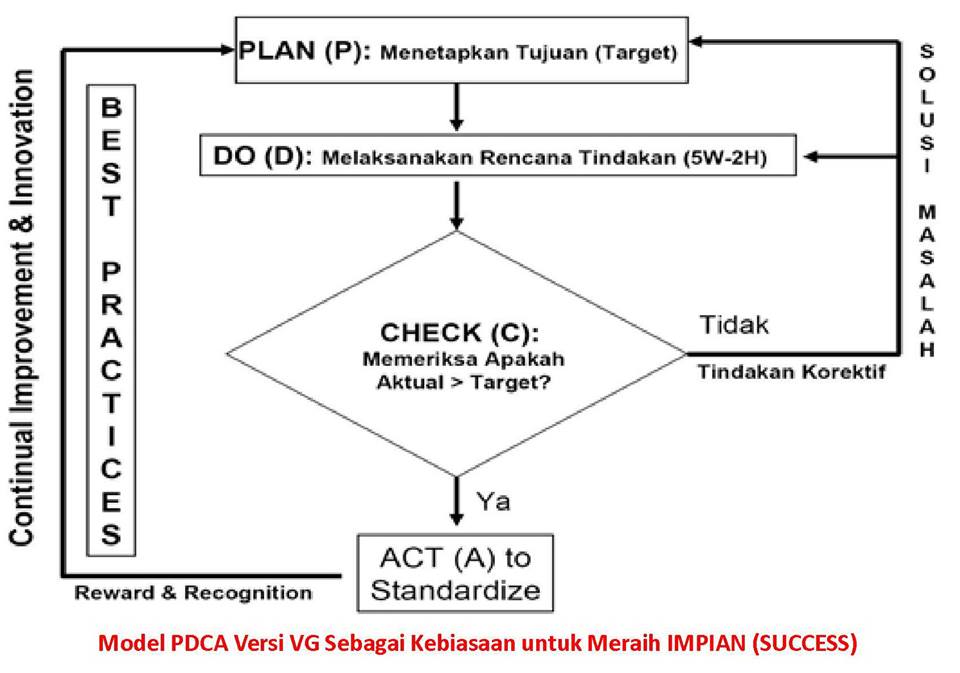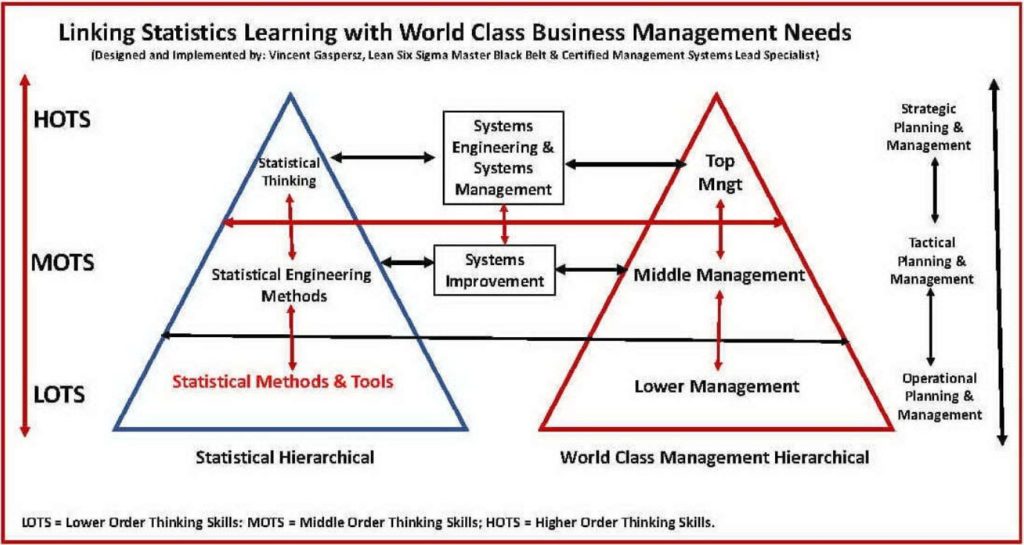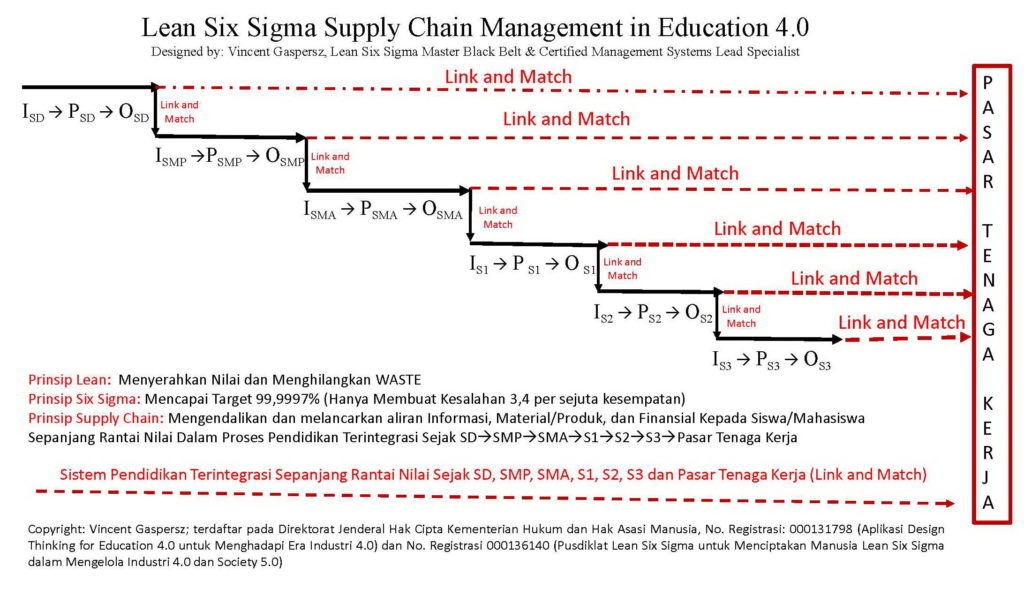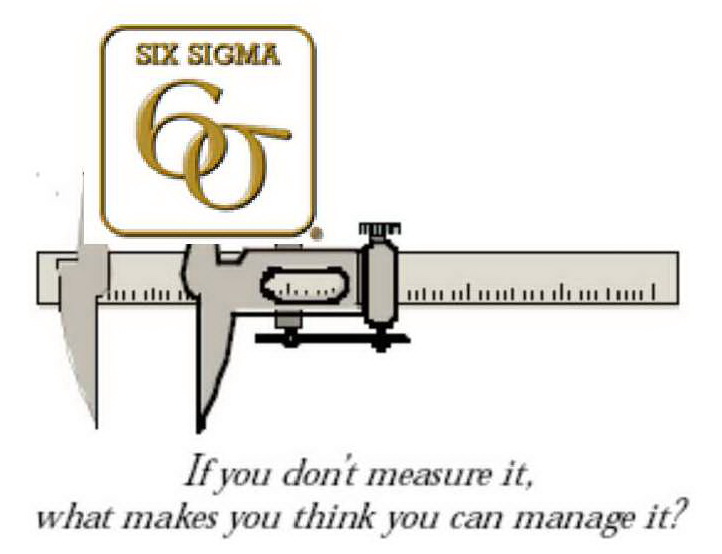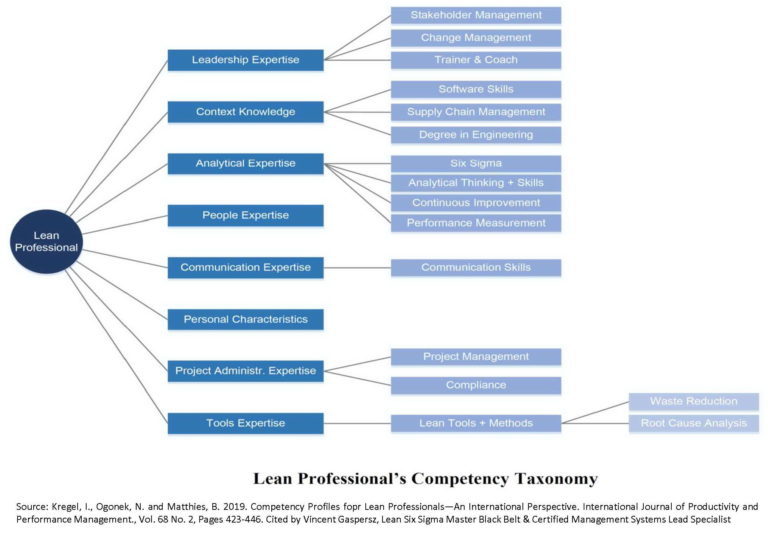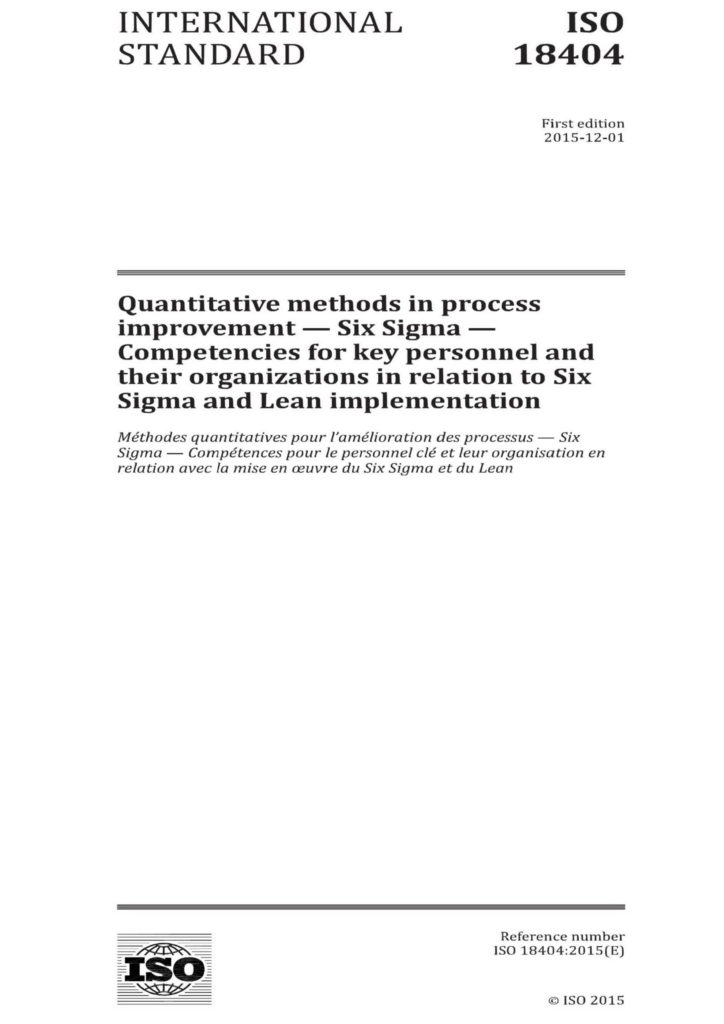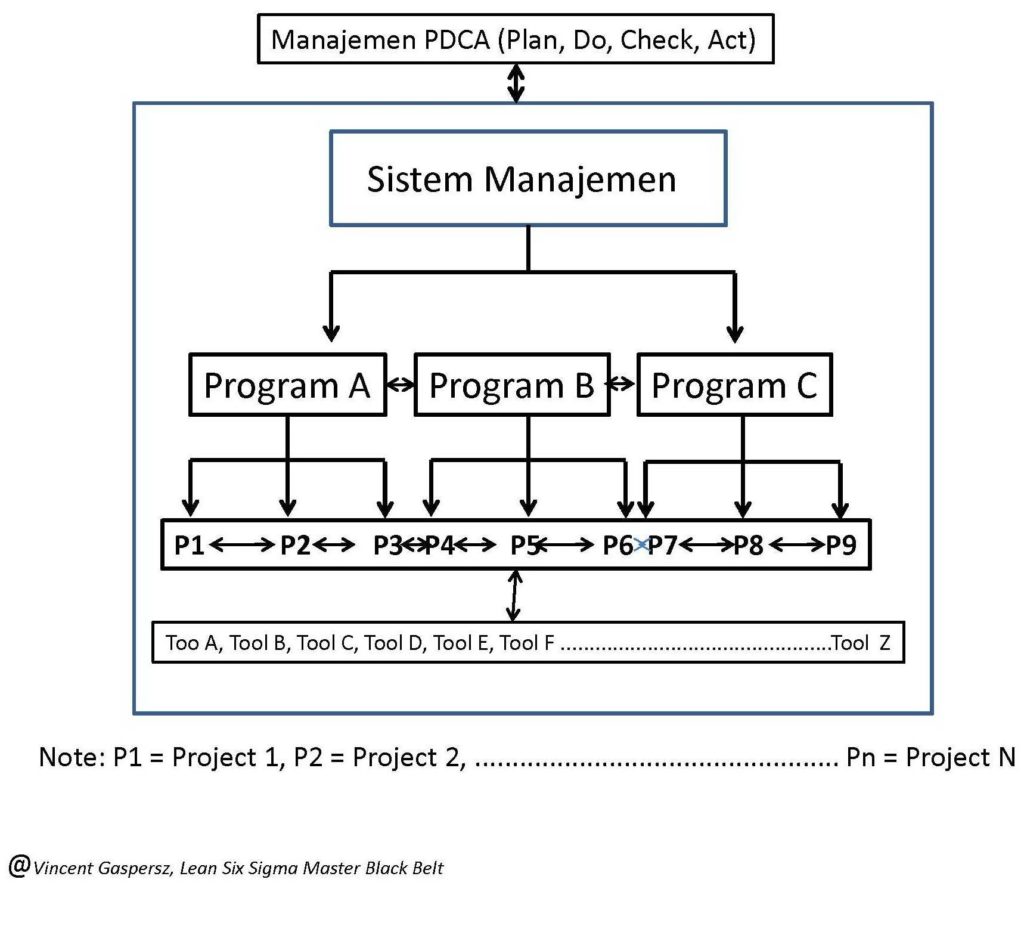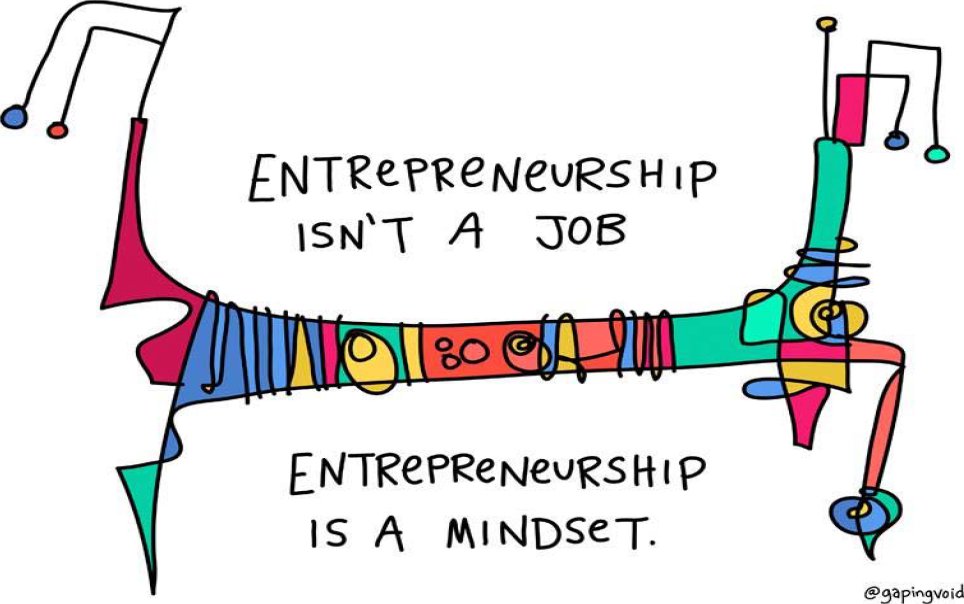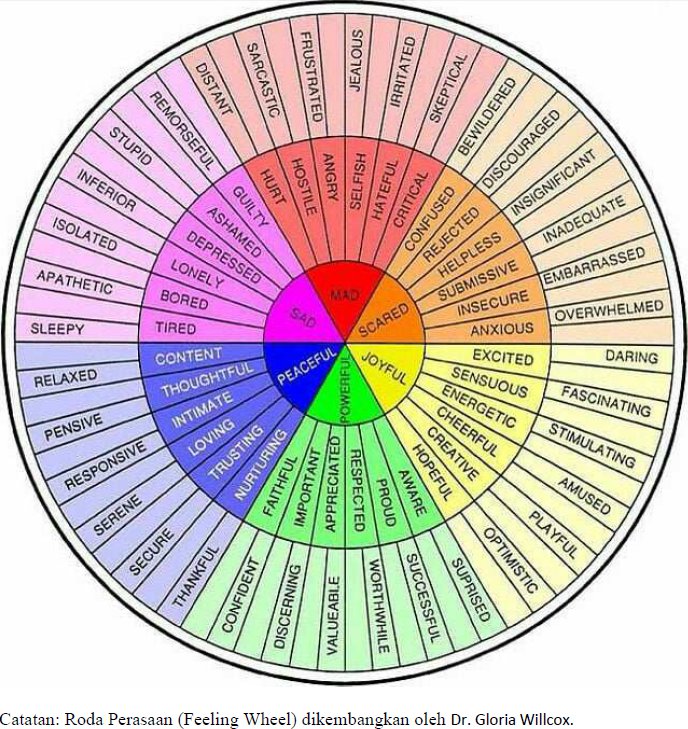-
Bahasa Indonesia
-
English
Oleh: Vincent Gaspersz, Lean Six Sigma Master Black Belt
John C. Maxwell penulis terkemuka dalam bidang Motivasi, Kepemimpinan, dan Manajemen PRAKTIS (PRAKtek TIDAK Sulit), dalam bukunya yang Berjudul: Mengembangkan Pemimpin Dalam Diri Anda (Developing the Leader Within You) mengemukakan tiga tingkat (level) orang dalam bekerja (memiliki keterampilan bekerja) sebagai seorang profesional, yaitu:
- Level 1: Orang yang bekerja lebih baik dibandingkan orang-orang lain, mereka ini disebut sebagai pengikut (follower).
- Level 2: Orang yang membantu orang lain agar bekerja lebih baik, mereka ini disebut sebagai manajer (manager).
- Level 3: Orang yang mengembangkan orang lain agar bekerja lebih baik, mereka ini disebut sebagai pemimpin (Leader).
Tentu saja semua organisasi di dunia mengharapkan untuk memperoleh sumber daya manusia pada Level 3, yaitu orang-orang yang MAMPU mengembangkan orang lain agar bekerja lebih baik. Dengan kata lain organisasi-organisasi kelas dunia (world class organizations) akan berusaha untuk mengembangkan system kepemimpinan (leadership system) dalam organisasi itu agar MAMPU menghasilkan semakin banyak pemimpin dalam organisasi itu. Kita TIDAK MUNGKIN akan mampu mengembangkan orang lain, jika kita sendiri GAGAL mengembangkan diri sendiri!
Bagaimana Menciptakan PEMIMPIN?
Saya pribadi (berdasarkan pengalaman aktual pribadi) selalu menyatakan bahwa kita sebagai seorang manusia (bibit unggul) berpotensi untuk menjadi PEMIMPIN melalui menerapkan kedua kata berikut, yaitu: PEMIMPIN = PEMIMPI + N, di mana PEMIMPI adalah orang yang memiliki IMPIAN dan N = NIAT (Nyatakan Impian Agar Terwujud). Jika huruf N itu HILANG, maka seseorang hanya akan menjadi PEMIMPI saja.
Jika demikian, apabila menggunakan kata PEMIMPIN = PEMIMPI + N ini, maka bagaimana kita MAMPU menciptakan diri kita sendiri agar menjadi seorang PEMIMPIN?
Pertama kali, kita HARUS berani menjadi PEMIMPI, yaitu orang yang memiliki IMPIAN, meskipun bagi orang lain hal itu akan menjadi MUSTAHIL.
Ketika menjadi sopir angkutan kota di Kupang – NTT (karena kemiskinan) sambil menjadi mahasiswa Fakultas Peternakan Universitas Nusa Cendana yang selalu GAGAL (tidak naik kelas dua kali di SMU dan tertahan dua tahun di Fapet Undana karena TIDAK LULUS mata kuliah Pengantar Statistika dan gagal mengikuti ujian sarjana peternakan karena bermasalah dengan Dekan Fapet Undana ketika itu yang menganggap ATTITUDE saya JELEK), saya TELAH memiliki IMPIAN akan bersekolah setinggi mungkin dan meraih semua gelar akademik (S1, S2. S3), jabatan akademik tertinggi (Professor), dan gelar-gelar professional (telah memiliki 10 gelar professional berstandar internasional). Ketika itu apabila saya menyatakan IMPIAN saya, maka semua orang menyatakan bahwa saya adalah orang TIDAK NORMAL, pengkhayal, dll. Padahal bukankah PEMIMPIN = PEMIMPI + N (N = NIAT = Nyatakan Impian Agar Terwujud)?
Mengapa kita harus BERANI memiliki IMPIAN (PEMIMPI)?
Ini beberapa alasan yang dikemukakan John Maxwell dalam bukunya yang berjudul: Peta Jalan Anda untuk SUCCESS (Your Road Map for SUCCESS), bahwa jika seseorang memiliki IMPIAN, maka ia akan memperoleh hal-hal POSITIF berikut:
- Sebuah IMPIAN memberikan ARAH pada kehidupan masa depan kita.
- Sebuah IMPIAN meningkatkan POTENSI kita untuk menuju kepada IMPIAN itu.
- Sebuah IMPIAN akan membantu kita agar menetapkan PRIORITAS.
- Sebuah IMPIAN akan menambah NILAI pada pekerjaan kita.
- Sebuah IMPIAN akan membantu memperkirakan (Prediksi) masa depan kita.
John Maxwell mengutip pernyataan Oliver Wendel yang menekankan bahwa: “Hal yang besar dalam dunia ini bukanlah di mana kita berada, melainkan ke arah mana kita akan bergerak”. IMPIAN kita akan membantu meng-ARAH-kan ke mana kita akan bergerak menuju masa depan kita.
Tentu saja agar saya pribadi TIDAK disebut HANYA sebagai seorang PEMIMPI, yaitu orang yang HANYA memiliki IMPIAN saja, maka saya HARUS menambah huruf N, agar menjadi PEMIMPIN = PEMIMPI + N (N = NIAT = Nyatakan Impian Agar Terwujud).
Ketika kita akan menyatakan IMPIAN kita melalui akronim NIAT (Nyatakan Impian Agar Terwujud), maka kita HARUS menerapkan rencana-rencana jangka panjang, jangka menengah, dan jangka pendek. Awal dari perencanaan ini berarti kita HARUS menerapkan PDCA (Plan-Do-Check-Act) ke dalam diri kita. Menerapkan PDCA berarti kita harus menerapkan manajemen diri (Self Management) yang terus-menerus akan membawa menuju IMPIAN kita itu. Ketika saya pribadi menetapkan IMPIAN saya pada tahun 1970-an, maka 25 tahun kemudian semua IMPIAN saya itu telah TERWUJUD. Pada saat kita TELAH membuktikan bahwa IMPIAN kita telah terwujud, maka kita boleh menyatakan bahwa kita TELAH SUCCESS menjadi PEMIMPIN (PEMIMPI + N/NIAT) bagi diri kita sendiri.
Uraian dari hal di atas menunjukkan bahwa Kepemimpinan (Leadership) dan Manajemen (Management) BUKAN sekedar dipelajari sebagai ilmu pengetahuan saja, TETAPI harus diterapkan dalam kehidupan sehari-hari sehingga menjadi KARAKTER!
Proses pembentukan KARAKTER ini HARUS di mulai dari: (1) memiliki MINDSET yang benar, (2) mengubah ATTITUDE agar sesuai dengan mindset yang benar itu, (3) menerapkan attitude positif sehari-hari agar menjadi HABITS, dan (4) mempraktekkan habits terus-menerus agar menjadi CHARACTER.
Saya berterima kasih kepada semua pihak yang terlibat secara sadar atau tidak sadar dalam pembentukan CHARACTER saya sekarang ini. Ketika ada ucapan bahwa ATTITUDE saya JELEK, maka saya HARUS segera memperbaikinya.
Kasus sederhana tetapi FATAL: Dekan menyuruh memindahkan motornya dari satu tempat ke tempat lain, TETAPI setelah menerima kunci motor itu saya mencari teman saya yang bisa naik motor agar memindahkan motor itu. Proses penyerahan kunci motor kepada orang lain ini dianggap kesalahan FATAL sehingga harus TIDAK BOLEH ujian (tertunda selama satu tahun). Saya menerima bahwa ATTITUDE yang JELEK harus mengalami kegagalan satu tahun, dan juga ketidaktahuan ilmu Pengantar Statistika juga harus dibayar melalui kegagalan satu tahun. Memang ANEH seorang yang sangat LINCAH mengemudikan mobil TETAPI tidak bisa naik motor (itu FAKTA sampai sekarang). Ke-SALAH-an saya: adalah tidak berterus-terang (TIDAK JUJUR) mengatakan bahwa saya TIDAK bisa naik motor! Bagaimana mungkin mau bisa belajar naik motor sedangkan waktu telah HABIS untuk mengemudikan angkutan kota BEMO (di Kupang Angkutan Kota disebut BEMO = BEcak MOtor) agar mencari biaya sekolah. HANYA orang-orang kaya saja yang bisa membeli motor pada tahun 1970-an di Kupang – NTT itu. Saya HANYA kaya MENTAL saja meskipun MISKIN material uang!
Agar pembelajaran karena kegagalan di atas TIDAK terjadi pada orang lain, maka sejak saat itu saya secara AKTIF mulai mempelajari apa itu KARAKTER orang-orang SUCCESS vs. Karakter orang-orang GAGAL, agar saya BISA meraih semua IMPIAN saya di masa yang akan datang.
John Maxwell telah mengidentifikasi beberapa KARAKTER penting orang-orang SUCCESS vs. GAGAL, dan menyimpulkan bahwa orang-orang SUCCESS bersedia melakukan hal-hal yang TIDAK MAU dilakukan oleh orang-orang GAGAL.
Perbedaannya sebagai berikut:
KARAKTER ORANG SUCCESS (PEMENANG):
- Mengerjakan dengan BENAR, kemudian merasa SENANG.
- Bekerja berdasarkan KOMITMEN untuk mencapai IMPIAN.
- Membuat keputusan berdasarkan PRINSIP yang benar.
- Membuat TINDAKAN yang mengendalikan ATTITUDE positif.
- Percaya kemudian MELIHAT.
- Menciptakan MOMENTUM.
- Selalu bertanya: “Apa TANGGUNG JAWAB saya?”
- Terus bekerja ketika muncul MASALAH.
- Bersikap TENANG.
- Menjadi PEMIMPIN.
KARAKTER ORANG GAGAL (PECUNDANG):
- Merasa SENANG, baru kemudian mengerjakan dengan BENAR.
- Bekerja berdasarkan KENYAMANAN.
- Membuat keputusan berdasarkan POPULARITAS.
- Membiarkan ATTITUDE negatif mengendalikan TINDAKAN.
- Melihat kemudian PERCAYA.
- Menunggu MOMENTUM.
- Selalu bertanya: “Apa HAK-HAK saya?”
- Berhenti bekerja ketika muncul MASALAH.
- Bersikap murung.
- Menjadi PENGIKUT.
Model PDCA yang Membawa VG Meraih IMPIAN Masa Depan
Saya TELAH memiliki kebiasaan menerapkan model PDCA (Plan-Do-Check-Act) dalam kehidupan sehari-hari sejak tahun 1970-an sejak diperkenalkan oleh Dr. William Edwards Deming sehingga disebut sebagai Roda Deming (Deming Cycle). Deming memperkenalkan dalam bentuk Roda berbentuk lingkaran yang membagi lingkaran ke dalam empat kuadran: P (Plan), D (Do), Check (C ), A (Act). Saya pribadi lebih suka menggunakan PDCA berbentuk flowchart sehingga saya membuat versi VG untuk keperluan PRAKTIS (PRAKtek TIdak Sulit).
Pada dasarnya terdapat enam langkah dalam siklus PDCA/PDSA, yaitu:
Plan (Merencanakan):
- Menetapkan sasaran dan target (NIAT = Nyatakan Impian Agar Terwujud)
- Menentukan metode untuk mencapai sasaran dan target (IMPIAN) itu
- Belajar terus-menerus tentang PDCA (Plan-Do-Check-Act)
Do (Melaksanakan):
- Menerapkan rencana tindakan (action plan). Dapat menggunakan metode 5W-2H (What, Why, When, Where, Who, How, How-much).
Check/Study (Memeriksa/Mempelajari):
- Memeriksa atau mempelajari hasil-hasil dari implementasi rencana tindakan (action plan) menuju IMPIAN kita.
Act (Mengambil Tindakan/Bertindak):
- Mengambil tindakan yang tepat dan menindaklanjuti hasil-hasil. Dua tindakan dapat dilakukan di sini, yaitu: tindakan korektif berupa solusi masalah, apabila sasaran dan target tidak tercapai. Atau tindakan standardisasi terhadap praktek-praktek terbaik yang telah dilakukan, apabila sasaran atau target telah tercapai. Selanjutnya kembali lagi pada tahap awal (Plan = Merencanakan) perbaikan atau peningkatan terus-menerus (continual improvement).
Contoh model PDCA versi VG untuk menjadi PEMIMPIN = PEMIMPI + N (NIAT = Nyatakan Impian Agar Terwujud) ditunjukkan terlampir.
John Maxwell menyatakan bahwa cara tercepat menciptakan ke-PEMIMPIN-an adalah belajar ilmu SOLUSI MASALAH agar kita terus-menerus menuju IMPIAN kita. Hal ini berarti: PEMIMPIN = PEMIMPI + N (NIAT = Nyatakan Impian Agar Terwujud) HARUS belajar ilmu SOLUSI MASALAH agar dia MAMPU terus bekerja ketika muncul MASALAH yang menghambat menuju IMPIAN kita. Ilmu SOLUSI MASALAH dan CONTINUAL IMPROVEMENT merupakan bagian yang melekat dalam diagram PDCA versi VG yang saya buat untuk kepentingan pribadi itu (lihat bagan terlampir).
Saya sejak dahulu lebih baik berfokus pada hal-hal POSITIF dan mencoba melakukan penguatan POSITIF (Positive Reinforcement) kepada diri sendiri. Kemudian mencoba mempengaruhi orang lain dari segi POSITIF. Jika ternyata dalam lingkungan keberadaan kita berhadapan dengan orang-orang yang NEGATIF, apalagi sampai pimpinan organisasi merupakan orang Level 3 (PEMIMPIN NEGATIF), maka bagi saya pribadi lebih baik meninggalkan lingkungan tersebut dan berkarya di tempat lain daripada saya harus mengorbankan masa depan saya.
Orang-orang yang berpikiran NEGATIF adalah karena TIDAK memiliki prinsip pribadi. Stephen Covey menyebut dengan orang-orang yang TIDAK memiliki PRIVATE VICTORY (Tidak Memiliki Kepercayaan Diri). 100% orang-orang yang berperilaku NEGATIF, karena PECUNDANG (LOSER) bagi diri sendiri, sehingga OTOMATIS mereka akan mengembangkan PECUNDANG lain juga agar kelompok mereka menjadi semakin banyak yang terdiri dari kelompok sesama PECUNDANG (LOSER People/Community).

PDCA (Plan-Do-Check-Act) telah digunakan secara resmi oleh ISO sebagai kerangka kerja untuk semua manajemen system yang dipublikasikan oleh ISO (the International Organization for Standardizations). Silakan baca keterkaitan PDCA dengan Sistem Manajemen Risiko (ISO 31000:2009) di sini:
https://idrismadjidi.wordpress.com/2013/03/14/risiko-dan-manajemennya-risk-risk-management/
Dalam ISO 9001:2015 klausul 6 tentang Planning harus ada Action Plan terkait risiko dan opportunities. Tentu saja kita harus mempertimbangkan risiko2 dan opportunities untuk setiap tindakan yg akan dilakukan sehingga mampu membuat Action Plan yg memperhitungkan risiko dan opportunities itu.
Salam SUCCESS.
Where is Your Position When Working as A Professional?
By: Vincent Gaspersz, Lean Six Sigma Master Black Belt
John C. Maxwell, a leading author in the field of Motivation, Leadership, and PRAKTIS (PRAKtek TIDAK Sulit) // PRACTICAL (PRACtice IS NOT Difficult) Management, in his book Titled: Developing the Leader Within You expresses three levels of people (who have work skills) in working as professionals, namely:
- Level 1: People who work better than other people; they are referred to as followers.
- Level 2: People who help other people to work better; they are referred to as managers.
- Level 3: People who develop other people to work better; they are referred to as leaders.
Of course all organizations in the world expect to obtain human resources at the Level 3, that is, people who are ABLE to develop other people to work better. In other words, a world-class organization will try to develop the leadership system within that organization in order to be ABLE to produce more and more leaders within that organization. We WON’T POSSIBLY be able to develop other people, if we FAIL develop ourselves!
How to Create a Leader?
I personally (based on actual personal experience) have always stated that each of us as a human (quality seed) has the potential to become a LEADER by implementing both of the following words, namely: PEMIMPIN = PEMIMPI + N // LEADER = DREAMER + N, where PEMIMPI // DREAMERS is someone who has a DREAM and N = NIAT (Nyatakan Impian Agar Terwujud) // INTENTION (State the Dream to be Materialized). If that letter N DISAPPEARS, then someone will only just be a DREAMER.
If so, when using this word PEMIMPIN = PEMIMPI + N // LEADER = DREAMER + N, then how are we ABLE to create ourselves to be LEADERS?
Firstly, we MUST dare to be DREAMERS, which are those who have DREAMS, although other people may consider them to be IMPOSSIBLE.
When I became a driver of city transport in Kupang – NTT (due to poverty) while being a student of the Faculty of Animal Husbandry at Nusa Cendana University who always FAILED (failed a grade twice in high school and was delayed two years in Animal Husbandry Faculty of Undana because I DID NOT PASS the Introduction to Statistics course and failed to take the Bachelor of Animal Husbandry exam because I had problems with the Dean of the Animal Husbandry Faculty of Undana back then who regarded my ATTITUDE as UGLY), I HAVE had a DREAM to pursue my education as high as possible and to grab all the academic degrees (Bachelor’s, Master’s, Doctorate), highest academic position (Professor), and professional titles (I already has had 10 international-standard professional titles). Back then when I expressed my DREAM, then everyone else declared that I was NOT NORMAL, a dreamer, etc. Whereas, isn’t it PEMIMPIN = PEMIMPI + N (N = NIAT = Nyatakan Impian Agar Terwujud) // LEADER = DREAMER + N (N = Intention = State the Dream to be Materialized)?
Why Should We DARE to Have DREAMS (be DREAMERS)?
Here are some reasons stated by John Maxwell in his book titled: Your Road Map for SUCCESS, that if someone has a DREAM, then he/she will get the following POSITIVE things:
- A DREAM provides DIRECTION to our future lives.
- A DREAM increases our POTENTIAL to go to that DREAM.
- A DREAM will help us to establish PRIORITY.
- A DREAM will add VALUE in our work.
- A DREAM will help estimating (predicting) our future.
John Maxwell, quoting Oliver Wendell’s statement, stresses that: “The great thing in this world is not where we are, but to which direction we will move”. Our DREAM will help DIRECTING where we will move towards our future.
Of course in order for me personally to not ONLY be referred to as a DREAMER, that is, someone who ONLY have DREAMS, then I MUST add the letter N, in order to be a PEMIMPIN = PEMIMPI + N (N = NIAT = Nyatakan Impian Agar Terwujud) // LEADER = DREAMER + N (N = Intention = State the Dream to be Materialized).
When we will state our DREAMS through the acronym of NIAT (Nyatakan Impian Agar Terwujud) // INTENTION (State the Dream to be Materialized), then we MUST implement long-term, medium-term and short-term plans. The beginning of this planning means we MUST apply PDCA (Plan-Do-Check-Act) into ourselves. Applying PDCA means we must implement Self-Management that constantly will lead us to those DREAMS of ours. When I personally set my DREAMS in the 1970s, then 25 years later, all my DREAMS have COME TRUE. The moment that we HAVE proved our DREAMS have been realized, then we may declare that we HAVE SUCCESSFULLY become PEMIMPIN (PEMIMPI + N/NIAT) // LEADERS (DREAMERS + N/Intention) for ourselves.
The description of those things above shows that Leadership and Management are NOT just studied as science courses, BUT they should be applied in daily life in order to become CHARACTER!
This CHARACTER-building process MUST begin from: (1) having the right MINDSET, (2) changing the ATTITUDE to match that right mindset, (3) applying positive attitude daily so to become HABITS, and (4) practicing habits continuously to become CHARACTER.
I thank all parties who have been involved consciously or unconsciously to the formation of my today CHARACTER. When there is a saying that my ATTITUDE is BAD, then I HAVE to fix it immediately.
An example of a Simple, but FATAL case: the Dean told me to move his bike from one place to another, BUT after receiving that bike’s key, I went looking for my friend who could ride a motorcycle in order to move that bike. The process of handing the bike’s key to someone was considered a FATAL mistake; thus, I OUGHT TO not be able to take exams(I was delayed for one year). I accepted that due to my BAD ATTITUDE, I should fail one year, and also my ignorance to Introduction to Statistics should also be paid through the failure of a single year. It is strange indeed that someone who was very agile in driving cars, BUT could not ride a bike (it is still the FACT until now). My MISTAKE: was not being straightforward (DISHONEST) to say that I COULD NOT ride a motorcycle! How could I possibly want to learn to ride a motorcycle while my time was SPENT OUT to drive a city transport of BEMO (in Kupang, a City Transport is called BEMO = BEcak MOtor // motorcab) for my school fees. ONLY rich people who could buy motorcycles back then in 1970s in Kupang – NTT. I was ONLY MENTALLY rich even though was POOR materially/monetarily!
So that the learning because of the failure above does NOT happen to someone else, ever since then I have ACTIVELY learned what are the CHARACTERS of SUCCESSFUL vs. FAILED people, so I that I CAN achieve all my DREAMS in the future.
John Maxwell has identified several important CHARACTERS of SUCCESSFUL vs. FAILED people, and concluded that SUCCESSFUL people are willing to do things that WILL NOT WANT to be done by FAILED people.
The differences are as follows:
CHARACTERS of SUCCESSFUL PERSON (WINNER):
- Working CORRECTLY, then feeling HAPPY.
- Working based on the COMMITMENT to achieve DREAMS.
- Making decisions based on correct PRINCIPLES.
- Making ACTIONS that control positive ATTITUDE.
- Believing then SEEING.
- Creating MOMENTUM.
- Always asking: “What are my RESPONSIBILITIES?”
- Continue working when PROBLEM appears.
- Being CALM.
- Becoming LEADER.
CHARACTERS of FAILED PERSON (LOSER):
- Feeling HAPPY, then working CORRECTLY.
- Working based on COMFORT.
- Making decisions based on POPULARITY.
- Letting negative ATTITUDE to control ACTIONS.
- Seeing then BELIEVING.
- Waiting for MOMENTUM.
- Always asking: “What are my RIGHTS?”
- Stop working when PROBLEM appears.
- Being moody.
- Becoming FOLLOWER.
PDCA Model that Takes VG to Achive Future DREAMS
I HAVE had a habit of applying the PDCA (Plan-Do-Check-Act) model in everyday life since the 1970s ever since it was introduced by Dr. William Edwards Deming; thus was also referred to as Deming Cycle. Deming introduced it in the form of circular wheels that divides the circle into four quadrants: P (Plan), D (Do), Check (C), A (Act). I personally prefer to use PDCA flowchart so I made the VG’s version for PRAKTIS (PRAKtek TIdak Sulit) // PRACTICAL (PRACtice ISN’T Difficult) purpose.
Basically, there are six steps in PDCA/PDSA cycle, namely:
Plan:
- Set goals and targets (NIAT = Nyatakan Impian Agar Terwujud // INTENTION = State The Dream to be Materialized)
- Determine the method to achieve those goals and targets (DREAM)
- Continuously learn about the PDCA (Plan-Do-Check-Act)
Do:
- Implement the action plan. Can use the 5W-2H (What, Why, When, Where, Who, How, How-much) method.
Check/Study:
- Inspect or examine the results of the action plan implementation towards our DREAM.
Act:
- Take the appropriate actions and follow up the results. Two measures can be done here, namely: corrective action in the form of solution to the problem, if the goals and the targets are not reached. Or perform standardization to the best practices that have been done, if the goals or targets have been achieved. Furthermore, go back to the early stage (Planning) of repair or continuous improvement.
An example of VG’s version of PDCA model to be a PEMIMPIN = PEMIMPI + N (NIAT = Nyatakan Impian Agar Terwujud) // LEADER = DREAMER + N (INTENTION = State The Dream to be Materialized) is shown in the attached picture above.
John Maxwell stated that the fastest way to create LEADERSHIP is by studying the knowledge of SOLUTION to PROBLEM so that we constantly go toward our DREAM. This means: a PEMIMPIN = PEMIMPI + N (NIAT = Nyatakan Impian Agar Terwujud) // LEADER = DREAMER + N (INTENTION = State The Dream to be Materialized) must learn the knowledge of SOLUTION to PROBLEM so that he/she will be ABLE to continue working when there are PROBLEMS that appear to hamper us toward our DREAM. SOLUTION to PROBLEM and CONTINUAL IMPROVEMENT are inherent parts in that VG’s version of PDCA diagram that I made for my personal interest (see the attached picture above).
I, since long ago, have believed that it is better to focus on POSITIVE things and try to do POSITIVE Reinforcement) to ownself. Then, try to influence other people in POSITIVE term. If it turns out that in our environment, we are dealing with people who are NEGATIVE, let alone leader of the organization is a Level 3 person (NEGATIVE LEADER), then for me personally, it is better to leave that environment and work somewhere else than having to sacrifice my future.
People who think NEGATIVELY are because they DO NOT have personal principles. Stephen Covey calls them people who DO NOT have PRIVATE VICTORY (Do Not Have Confidence). 100% of people who behave NEGATIVELY are LOSERS for themselves, so that AUTOMATICALLY they will also develop other LOSERS in order for their group to consist more of fellow LOSERS (LOSER People/Community).

PDCA (Plan-Do-Check-Act) has been used officially by ISO as the framework for all management systems published by ISO (the International Organization for Standardizations). Please read PDCA association with the Risk Management System (ISO 31000: 2009) here:
https://idrismadjidi.wordpress.com/2013/03/14/risiko-dan-manajemennya-risk-risk-management/
In ISO 9001: 2015, clause 6 about Planning, it states that there should be Action Plan associated with risks and opportunities. Of course we must consider risks and opportunities for every action to be taken in order to be able to make the Action Plan that takes into account those risks and opportunities.
Best Regards for SUCCESS.
